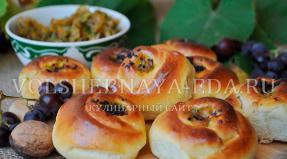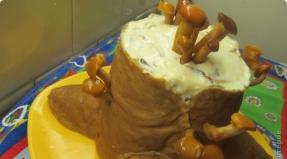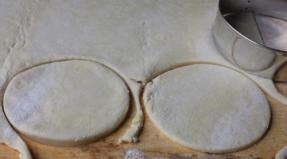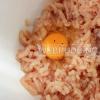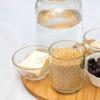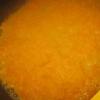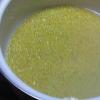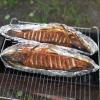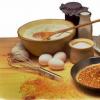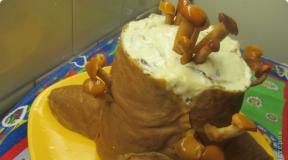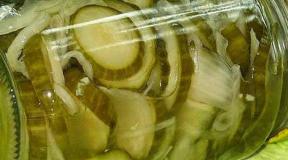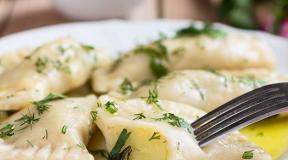There must be Kulich. How to bake Easter cake - recipes for Easter
Hello, dear hostesses!
Kulich is an Easter holiday cake. The custom of baking Easter cakes, painting eggs and exchanging them on Easter has been preserved among the people to this day.
When preparing EASTER Easter cake, many housewives often have questions: HOW TO DO IT RIGHT? WHAT EXACTLY? WHY? WILL IT WORK?...
Today I will share with you the verified “golden rules” that are followed in our kitchen when preparing Easter cake. I will share the information that I own and use myself.. Maybe it will be useful to someone!
When baking Easter cakes, you need to remember the following:
FLOUR
· Amount of flour necessary to obtain a good dough depends on the quantity and quality of the liquid components, i.e. milk, kefir, curdled milk, their density, the freshness of the yeast, the moisture content of the fats, as well as the quality of the flour itself. Flour must be of the best grades.
· The flour must be dry. Put the flour on the radiator in the evening, excess moisture will go away.
· Before kneading the dough, the flour should be sifted several times, At the same time, it is saturated with oxygen, and the resulting dough will be fluffy and tender.
This flour produces a fluffy and light dough.
YEAST
· It is better to use fresh, light yeast with a pleasant yeasty smell.
Yeast is diluted with warm (!) milk or warm (!) water, adding sugar to activate it. Cold milk (water) slows down the activity of yeast fungi, and hot milk leads to complete suppression of their activity.
· if the yeast is not fresh, it must be “activated”.
To do this, finely crumble and dilute in 0.5 cups of warm milk, add 1 - 2 teaspoons of sugar, stir and leave for 10-15 minutes: The appearance of bubbles and foaming indicate the activity of the yeast, therefore, the possibility of using it.
MILK
· It is best to use milk to make Easter cake. It improves the viscoplastic properties of the dough and enhances the loosening process.
· Milk It is best to bring to a boil and cool to room temperature.
· Instead of fresh milk for yeast dough you can use sour milk, yogurt, kefir, buttermilk, sour cream, cream, whey and other fermented milk products.
FATS
· Fats ensure the plasticity of the dough, give the finished product fragility, tenderness, aroma, and prevent staleness.
· The amount of fat added to the dough should not be exceeded as specified in the recipe. , since excess fat impedes the work of yeast, as a result of which the loosening of the dough is reduced or completely stopped, while the ability of flour proteins to swell is limited, the dough becomes torn, difficult to shape, and the finished product is tasteless.
· Butter must be the latest. Before adding it to the dough, you need to melt it, let it sit, then pour the warmest, purest (without suspensions) into the dough.
· If you add vegetable oil to the dough , then the cake stays fresh longer.
· So that the dough is viscoplastic, elastic, tear-resistant, light and convenient for cutting and shaping, it is recommended to add both butter and vegetable oil.
EGGS
· Eggs (especially protein) impart rigidity and hardness to the dough; products made from such dough quickly become stale.
· If you decide to add to the dough whole eggs, then it’s better to spend 3-4 minutes and beat the whites and yolks separately, as for a sponge cake. In this case, the Easter cake will turn out more fluffy and tender.
· Yolks It is necessary to carefully separate from the proteins, strain through a sieve and only then thoroughly beat them until white.
· For whipping proteins Porcelain or copper cookware should be used, but not aluminum. It should be dry and clean. Whisk squirrels slowly at first, gradually increasing the pace and without breaks. Whipped squirrels add to the dough while stirring gently. If you stir intensively, the proteins “settle” and the dough product turns out dense and unbaked;
SALT
· Coarse salt is dissolved in the liquid on which the dough is kneaded. Fine salt is placed directly into the dough, which is prepared without liquid. However, you should not add salt directly to the dough - it kills yeast.
· WHEN CONNECTING MIXTURES WHEN KNEADING THE DOUGH, ADD THE LIGHT MIXTURE TO THE HEAVY MIXTURE, BUT NOT THE VICE VERSE!
CANDIED FRUIT
Soak watermelon, melon, pumpkin or citrus peels in cold water for 3-4 days, then pour in thick sugar syrup and cook like jam. Then remove the candied fruits from the syrup and sprinkle with powdered sugar. Store them in a tightly closed container.
SAFFRONVO - OIL MIXTURE
The dough will have a bright yellow color and a characteristic aroma if it is tinted with saffron tincture. Thoroughly grind the dry saffron stamens, pour a glass of vodka over them and place them in a dark, dry place for 14 days. Store the tincture in a tightly closed glass bottle. And when you prepare the dough for the Easter cake, dilute a few drops of saffron tincture in 1 tsp. boiling water, add 1 tbsp. l. melted butter and mix well.
DOUGH
· Easter cake loves heat , so avoid drafts while kneading and resting the dough.
· It is better to knead the dough with a wooden spatula, in this case it will turn out fluffy and airy.
· Easter cake dough should not be liquid (the cakes will spread and be flat) and should not be thick (the cakes will be too heavy and will quickly become stale).
· The cake dough is kneaded for as long as possible so that it completely lags behind your hands or the table.
· The dough must rise three times : first time the dough is suitable, second time- when all products have been added, the third time- when the dough is placed in molds.
BAKING DISH
· Forms can be tin, copper, cardboard and have different shapes.
· Baking pans are greased with oil and the bottom is covered with oiled foil.
· The pan for baking Easter cakes is filled only halfway with dough, allowed to rise to 3/4 of the height of the pan, and then placed in the oven.
OVEN
· The oven must be preheated well. The baking temperature for Easter cakes should be = 180°.
· At a temperature of 200-220 degrees, bake the cake in a humidified oven (to do this, place a container of water down).
· On average, an Easter cake weighing less than 1 kg is baked for 30 minutes, weighing 1 kg - 45 minutes, weighing 1.5 kg - 1 hour, weighing 2 kg - 1.5 hours.
· To ensure that the cake rises evenly, a wooden stick is inserted into the center before baking. After a certain time, the stick is removed. If it is dry, the cake is ready.
· If the cake starts to burn on top, cover it with dry paper or foil.
· The finished cake is removed from the oven, placed sideways on a pillow and left in this position, rolling it periodically until completely cooled. At the same time, the cake “ripens”.
GLAZE
The Easter cake, ready for baking, is brushed with an egg beaten with 1 tbsp. spoon of water and butter, sprinkle with nuts, coarse sugar and breadcrumbs.
Ready-made Easter cakes can be glazed with any glaze or fondant.
For glaze: 1
Beat 2 egg whites with 200 g of powdered sugar until a thick, airy mass is obtained and add lemon juice to taste.
For glaze: 2 (custard protein cream)
· 3 egg whites,
· 1 cup of sugar,
· 0.5 cups of water (or a little more),
· 1 teaspoon lemon juice (citric acid).
Method for preparing custard protein cream:
To prepare the glaze, add water to the sugar (the water should slightly cover the sugar), stir and keep over high heat, stirring constantly and skimming off the foam, until the liquid thickens. To test for readiness, scoop out some syrup and place it in cold water. If the cooled syrup can be formed into a soft ball, it is ready. Remove from heat and add lemon juice. Mix. If you are using citric acid, it should be added at the beginning of preparing the syrup. It is added so that the syrup does not darken when boiling.
Separately, beat the egg whites until they increase in volume by 3-4 times. Pour hot syrup in a thin stream and continue whisking without ceasing until smooth. After cooking, the glaze (custard protein cream) can be applied to the prepared Easter cake.
If the cakes have become stale, you can refresh them , cut off the top layer, moisten with a small amount of syrup:
· a glass of strong wine,
· a glass of water,
· a full tablespoon of sugar
mix, heat and soak the cake with the prepared syrup. Then put it in a hot oven for 15-20 minutes (you can wrap the product in parchment paper). The cake will become tastier as it will become saturated with flavor.
I wish you success!
The Easter table is essentially a ritual cuisine, so most of the dishes are prepared according to established traditions. How was it customary to set the Easter table in Rus'? What dishes were historically required, and how was the Easter table decorated? What recipes for the Easter table are popular, what customs and signs are associated with treating the main Christian holiday?
All this is discussed in two articles about the Easter table.
In the first article you will find a selection of the most famous and traditional Easter recipes for Easter cakes and Easter:
Decorations for Easter cake
The Easter cake itself looks quite ordinary, so housewives decorate it in various ways. The number of options is growing every year, so you can easily create a unique dish in your kitchen that will be different from the store bought one. What are the most popular ways to decorate holiday cakes?
Powdered sugar. Simply sprinkle a generous amount of powdered sugar on top of the cake – it looks beautiful and tastes great.
Ready-made culinary coating : it can be multi-colored, plain, look like beads or short sticks. It contains food coloring and sugar, so it is perfect for decorating sweet Easter cakes.
Glaze. It is very easy to prepare: heat the water, pouring sugar and vanillin into it until you get a thick mass. If you add a little food coloring, the glaze will turn out colored. The only difficulty is that sugar hardens quickly, so the mass needs to be kept warm.
Cooking mastic . It can either be purchased at the store or prepared at home. Take a chewy marshmallow and add a little butter to it. Heat everything in the microwave until smooth. After this, add powdered sugar and knead like flour until the consistency becomes like plasticine. You can make flowers, the letters “XB”, miniature eggs and any other edible figures from culinary mastic.
You can decorate the cake with nuts or candied fruits However, it is better to sprinkle them on top of the still fresh glaze so that they stick.
Dough decorations : An interesting option is to decorate the cake even before baking, making petals, flowers or symbolic letters from pieces of dough.

Easter cake dough does not tolerate drafts, so place it in a warm place. Otherwise it won't rise.
The batter will spread over the pan and the product will be flat, and if you make it too thick, the cake will be tough and quickly go stale.
The oven must be humidified: to do this, place a container of water down.
A stale cake can be revived. To do this, cut off the top and pour inside a heated mixture of a spoonful of sugar and 30 grams of cognac or Cahors (sugar should completely dissolve). After this, wrap the product in baking paper and place in an oven preheated to 150 degrees for 10 minutes: the baking will become soft and fragrant again!
Curd Easter
Another obligatory dish on the Russian Easter table is cottage cheese Easter. Easter is celebrated only once a year, and many people look forward to it. The main ingredient is cottage cheese, and it is fatty, otherwise the Easter will not hold its shape and will simply “spread”. Of course, the result is a fairly high-calorie dish, but for such a holiday everyone can afford it. There are a lot of options for preparing cottage cheese Easter; they amaze with their variety and unusual solutions. However, there are also basic ones that are traditional for a Christian feast.
Raw Easter recipe
What you will need
- 700 grams of cottage cheese;
- half a liter of cream (at least 33% fat content);
— 100 grams of butter;
- two teaspoons of vanilla sugar;
- two eggs;
- salt;
- half a glass of powdered sugar;
- candied fruits and confectionery sprinkles for decoration.
How to cook raw Easter
First of all, beat the cream together with half the powdered sugar. Egg yolks must be separated from the whites and ground with the rest of the powder. Beat the whites well with a pinch of salt.
Grind the cottage cheese with cream, butter and yolks, then add vanilla sugar and whites to it. Line the Easter pan with a double layer of gauze, then place the curd mass on top. Fold the edges of the gauze inward. Be sure to put a weight on the workpiece and leave it in the refrigerator overnight.
In the morning, you need to take out the Easter, remove the gauze, and decorate with candied fruits and powder. Or you can put traditional Christian symbols on the edges - “XV” and a cross.

Boiled Easter recipe
What you will need
— 200 grams of butter;
- a kilogram of cottage cheese;
— 200 grams of sour cream;
- 5 eggs;
- nuts, vanilla, candied fruits, sugar to taste.
How to cook boiled Easter
Lightly beat the eggs with sugar, add butter and sour cream. You can melt the butter first, but this is not necessary. Place everything in a thick-bottomed saucepan, place over medium heat and stir constantly until the mixture boils. After this, you need to put the cottage cheese there and bring to a boil (the cottage cheese will “bubble”), add sugar, spices, candied fruits and nuts. The preparation for Easter must be cooled and placed in cheesecloth, hanging for a day so that the whey can be drained (if desired, it can be poured out or used for baking).
Transfer the curd mixture into a mold and refrigerate overnight. A ready-made dish will be waiting for you in the morning! If desired, it can be decorated with powdered sugar or leftover candied fruits and nuts.
Pink Easter
This Easter is called so because of the color. Classic white is a good tradition, but no one forbids you to play with the color and design of the dish! Place, for example, a pink Easter on the Easter table.
What you will need
— 100 grams of butter;
— 400 grams of pre-compressed cottage cheese;
- 100 grams of raspberry jam (preferably thick, without a large amount of syrup);
- a quarter glass of sugar;
- a glass of sour cream;
- two eggs.
How to make pink Easter
The cottage cheese must be rubbed through a sieve so that it becomes crumbly and does not stick together in lumps, then mixed with raspberry jam, sugar and eggs. Then add softened butter and sour cream to the mixture and mix the dish thoroughly. Now it can be placed in a form lined with gauze and placed under weight in the refrigerator overnight. Easter will have a rich pink color and a pleasant raspberry flavor.
Little tricks:
Cooking Easter is not a problem even for an inexperienced cook, but it still doesn’t hurt to know some subtleties:
— cottage cheese must be fatty, high quality, dry and homogeneous, otherwise the dish will not be stable and will not be able to keep its shape;
— for Easter you need a special shape, but, in principle, it can be replaced with a ceramic or plastic flower pot with a hole at the bottom.
Painted eggs
Traditionally, eggs are painted on Thursday, and on Easter all believers give them to each other, congratulating them on the bright holiday of the Resurrection of Christ. Nowadays, there are many ways to color shells, but since ancient times, natural pigments obtained from onion peels or birch leaves have been used to give eggs color. In the first case they will turn out red-brown, in the second - golden yellow.

Read about how to paint and decorate eggs.
You can fully express your imagination by making patterns on the shell with rice, leaves, threads, or
It is difficult to imagine a festive table for Easter without a beautiful, fragrant and, of course, delicious Easter cake.
Homemade cake, although it requires quite a lot of time and effort, can never compare with store-bought.
Prepared only from natural products and with love, it will create a unique Easter atmosphere in the house and will not go stale within a week and a half. In order to get a delicious Easter cake, you need to make the dough for Easter correctly.
By the way, don’t forget to decorate the eggs for Easter; they, like Easter cake, are traditional for the festive feast on this Bright Sunday.
Along with Easter cake and eggs, the table is decorated with Curd Easter .
Beginning housewives and experienced cooks who are worried about the results of their efforts should refresh their memory with a few tips on preparing a real Easter cake.
Recipe for success: how to prepare dough for Easter
1. Careful preparation.
All products needed for the recipe should be prepared in advance. Eggs and milk must be taken out of the refrigerator in advance, butter must be softened, raisins must be soaked, nuts must be chopped. The same applies to dishes: everything you need should be at hand, washed and wiped dry.
2. High-quality flour.
To make the yeast dough for Easter cake fluffy and tasty, you need to use only the best flour for its preparation. It should be stored in clean containers, in a dry and dark place. If the flour is damp or there are insects in it, under no circumstances should you knead Easter cake dough from it.
3. Natural yeast.
Many housewives try to follow modern trends in cooking and, in particular, replace natural yeast with dry yeast. Perhaps in some cases this product really justifies its popularity, but it is not suitable for making Easter cakes. Easter dough made with dry yeast is less suitable and goes stale much faster. However, natural yeast, if it is stale, can also cause a fiasco.
The amount of yeast is also important. The average recommendation is 50 g per 1 kg of flour. However, if the Easter recipe involves the use of a large number of eggs and dried fruits, it is recommended to increase the percentage of yeast by a third.
4. Spices.
Any baked goods need spices. But there shouldn’t be a lot of them in the Easter cake dough. The purpose of spices is only to emphasize its taste, but in no case to interrupt it.
Therefore, it is usually enough to limit yourself to a small amount of vanilla, cardamom or nutmeg (sometimes cinnamon or ground cloves are added, but this is not for everyone).
A little lemon or orange zest will add a pleasant citrus note, and a teaspoon of natural ground saffron or turmeric will add a pleasant color.
Using cocoa you can make an unusual chocolate cake.
5. Correct dough.
The sponge dough for Easter cake should be very well kneaded. Traditionally, this is done by hand for 20-30 minutes, clockwise. Under no circumstances should you interrupt or change direction. You can, however, make your task easier by calling on a mixer to help you initially mix the components. A sign that the dough is ready is when it stops sticking to the walls of the dish and your hands.
6. Constant temperature.
The main enemies of Easter cake dough are sudden temperature changes and drafts. It is best to let it rise indoors at room temperature. But you shouldn’t heat the dough or put it in a lukewarm oven, as is sometimes recommended to speed up its rise.
7. Shape and size.
Since Easter yeast dough increases in volume at least twice during baking, Easter cake pans are usually filled only halfway. If you want to get a product with a less dense texture, you can leave two thirds of the mold free.
The size of Easter cakes almost entirely depends on the preferences of the hostess, but it should be remembered that too large copies may remain raw in the middle, and too small ones risk turning out to be too dry.
8. How to bake Easter cake.
The oven must be preheated to the required temperature. After placing Easter in the oven, try to open the door as little as possible during the entire baking time.
If the cake has acquired a golden brown crust on the outside, but is not yet baked inside, you can put a circle of baking paper on top of it: this will help it not to burn.
9. How to cool the cake.
Cooling Easter cake is a science. Due to the high density of the dough, this requires a long time and cannot be rushed. The baked hot cake must be wrapped in a towel and placed on its side. To ensure that it cools as evenly as possible, it will sometimes need to be rolled. Even if the outside of the cake is already cold, you must wait until it has completely cooled down inside. On average it takes 3-4 hours. Be patient and take your time so that your cake remains fresh for a long time and does not go stale.
10. Preparing the glaze.
The traditional icing for Easter cakes is egg white beaten with sugar. But it can be any other glaze at your discretion. Its main function, in addition to decoration, is to preserve the freshness of the product longer. Important condition: only completely cooled cakes are covered with glaze.
11. Positive attitude.
Along with all the tips listed, the mood of the hostess is no less important. Since ancient times, it was no coincidence that yeast dough was considered almost a living organism; in Rus' it was forbidden to swear, shout, or get angry with it - these were sure signs that the dough would not rise and would generally fail.
Therefore, before making Easter cake, try to forget about everyday stress and problems for a while, put aside all other things and focus on good and bright thoughts. And then the cake will “thank you” and be a great success!
Rules and secrets of making Easter cake
Easter cake dough is perhaps the most capricious and requires special knowledge, skills and, of course, dexterity. The famous pastry chef Alexander Seleznev talks about how to place the dough and how to knead the dough to get the perfect Easter cake.
What should the dough for Easter cakes be like?
Yeast and rich - this is a must. Easter cake dough contains a lot of butter, eggs, sugar, milk or cream. And, of course, candied fruits, dried fruits, and raisins are added to it.
Is Easter cake dough usually finicky?
It's complex. Doesn't like drafts, doesn't like being disturbed once again. If you covered the dough, you don’t have to go every five minutes and check whether it has risen or not. We kneaded the dough, set it, covered it and waited for it to ferment.
Again, it is better to knead Easter cake dough using fresh yeast, but fresh yeast is difficult to buy. Because they have a short shelf life. So, if you come across high-quality yeast, you can freeze it and then store it for a very long time.
About yeast and dough
How to calculate the amount of yeast for Easter cake?
Live yeast is used in a one to two ratio - 22 grams of live yeast per 500 grams of flour. Dry, I prefer French: one sachet ( 11 grams) for 500 grams of flour.
How to make the dough?
For one tablespoon of yeast you need to take one teaspoon of sugar, about 50 ml of warm water and flour and mix it all. Ideally, there should be enough flour so that the consistency of the dough becomes similar to not too thick sour cream. Sugar and flour are added to yeast so that it begins to feed, multiply and divide. If you place the dough in a warm place, it will definitely be ready in 30-60 minutes.
In order for the yeast to begin to “grow” faster, the dough can be made without water and flour. Take fresh yeast and sugar ( source of nutrition and reproduction of yeast) in a one to one ratio and mix. The sugar will begin to melt quickly and the yeast will increase in volume in a couple of seconds.
What absolutely cannot be added to the dough?
If you add salt to the dough, it will not rise at all. Salt kills the fermentation process. Vegetable oil is never added to the dough. A fat film envelops the yeast - they will not be able to take food.
How do you know when it’s time to add the dough to the dough?
We must not forget about the dough. First it rises, and then it begins to fall. It is this moment that indicates that the dough is ready and it’s time to add it to the dough.
Some people make a big mistake: they let the dough rise, then it falls, as expected, but they leave it, deciding that when it comes up a second time, it will become even better. The dough rises, but not so high, because the yeast in it is already beginning to die, because they have nothing else to feed on: they have already processed all the sugar and multiplied.
About the dough
What flour is suitable for Easter cake?
Highest or first grade. Before kneading the dough, you need to sift it twice to saturate it with oxygen and remove foreign impurities.
What temperature should the dough products be at?
Same room temperature. You must remove the ingredients from the refrigerator about two hours before you start kneading the dough and let them stand at room temperature.
What are the common mistakes when kneading dough?
Many people dilute milk with yeast, add sugar, eggs and then add flour. But it should be the other way around. Flour cannot be poured into liquid because there will be lumps. Our grandmothers also knew the right way: they poured a heap of flour on the table, made a hole and added eggs there, then poured in the liquid and began to knead the dough. The same goes for Easter cake. Sift the flour, make a hole, pour in the eggs, add the dough and only then add the liquid. This could be water, milk or cream. And you start kneading dough.
And, so that the fatty environment does not envelop the yeast and they can feed, soft butter is added to the dough last. You can tell when the dough is ready and gathered into a ball. After the butter is added, everything must be stirred for a very long time. Until the oil is completely absorbed into the dough, which will stick to everything at first because you added fat. But when you mix it until smooth, it will immediately begin to stick both from the walls of the dishes and from your hands.
Does it matter what exactly you use to knead the dough?
You can knead either with a mixer for 20-30 minutes, or by hand for 40-60 minutes. My grandmother always said that you should knead the Easter cake dough until the sweat disappears from the back of your head to your lower back. Only then can the dough be considered ready. Therefore, it is better to take a mixer or food processor with a hook attachment. In order for the cake to come out porous and rise, the yeast must be distributed evenly throughout the entire volume of the dough.
When is the right time to add dried fruits and nuts?
Dried fruits, nuts and candied fruits are added to the dough at the very last moment. The raisins must be sorted so that there are no seeds, sticks or debris. Be sure to wash and preferably soak. I like to soak raisins in cognac or rum, or in orange or apple juice to swell them. Then it will become juicy and will burst when you eat the cake. You can also add candied orange peels and candied lemon peels.
When the dough is kneaded, it should stand for an hour and a half in a warm place, covered with a linen napkin or towel, to rise. If you add nuts, raisins or dried fruits right away, it will be difficult for the dough to rise. These supplements are his " will be imprisoned“and it simply won’t rise.
How to proof Easter cake dough correctly?
So, you kneaded the dough, covered it with a towel and put it in a warm place. ( Keep in mind that during the first batch the dough may increase in volume ten times or even more..) To allow the dough to proof, you need to knead it twice. My grandmother stopped him, hitting him with her fist, but you could also hit him with her palm. When the dough has risen for the first time and after about an hour, when the dough has risen for the second time. Now you can add raisins, nuts, dried fruits and candied fruits. Add and stir. Leave the dough again to rise a third time, and only then put it on the table.
What's next?..
The table should be greased with vegetable or melted butter. It is not advisable to sprinkle flour: the dough will dry out and take on excess flour. But we don’t need this: then the cake will be difficult to rise. We also grease our hands well with oil and begin to form small pieces of dough of 300-400 grams, which it is advisable to place in special cake pans. They are coated with silicone, which means the dough will not stick. The form should be one-quarter or one-third full.
And can you put it in the oven?
No. Cover the molds with gauze or a towel and again leave to proof in a warm place for about an hour. You can even put it in a closet. And be sure to place a cup of water next to it for moisture so that the dough does not dry out. And when it comes almost to the very top of the pan again, you can put the cake in the oven.
If the mold is not silicone, but metal, then you must line its bottom and walls with parchment, otherwise the cake will stick. It won’t even help if you grease the pan with butter and sprinkle with breadcrumbs, because the Easter cake dough is very delicate.
How long to bake the cake?
Big Easter cake 40-50 minutes, or even an hour at 180°C. If the Easter cakes are small, they are baked for 20-30 minutes at 220°C. Keep in mind that the larger the cake, the lower the temperature and the longer the baking time. Therefore, you should not put a large Easter cake and small ones together.
If the dough fails in the middle, what's the problem?
The dough just wasn't baked. The Kulich was not ready. Or they often opened the oven; the heat came out and the temperature dropped - this could also cause the cake to fail.
If the surface of the cake is uneven or rises from one side?
This means that the dough was poorly kneaded, and there was more yeast in one place than in another. The reason may also be a malfunctioning oven. When the heat is stronger on one side and less on the other.
How long before you can look into the oven?
In about 30-40 minutes, but it’s still not advisable to do this. You can only open it if you see, for example, that the crust is starting to burn. Then place some foil or parchment on it to reduce the heat from above.
How to remove the cake from the mold?
You can’t immediately take it out of the mold. The sides of a freshly baked Easter cake are not quite dense and may sag. Therefore, leave it in the mold until it has cooled completely, and only then take it out.
Once the cake has cooled, the surface should be greased with melted butter. This will increase the storage time of the cake. If you want to store the cakes for a long time, you need to cover them with a linen towel and leave them in a warm place. Thanks to the large amount of sugar, eggs and fat, the cake can be stored for a week.
I always cook Easter cake with cream. It turns out airy, almost weightless. I discovered this recipe about five years ago and have used it every year since then.
Kulich with cream from Alexander Seleznev
For the test:
- 640 g flour
- 5 eggs (250 g)
- 200 g sugar
- 200 ml cream (fat content 22%)
- 100 ml milk
- 100 g seedless raisins
- 100 g candied fruits
- 25 g dry yeast
- a pinch of salt
For the glaze:
- 200 g powdered sugar
- 1 protein (30 g)
- 1 tbsp. l. lemon juice
What to do:
Dissolve yeast in warm milk, add a pinch of sugar and 2 tbsp. l. flour. Let it rise for 20 minutes.
Sift the flour, add lightly beaten eggs with sugar, salt and dough. Knead the dough and gradually pour in the cream. Knead the dough for at least 5-10 minutes with a mixer with a hook attachment.
Place the dough in a warm place and let it rise for 1 hour, knead it, let the dough rise again, knead it, add raisins and candied fruits to the dough and mix until smooth. If you are in a hurry, just let the dough rest for an hour and, after kneading it once, add raisins and candied fruits.
Why are Easter cakes baked for Easter? Many people, raised in the traditions of Christianity from childhood, do not even think about where this custom came from, because Easter cake has always been the main decoration of the Easter table, along with Easter cottage cheese and colored eggs.
However, if we turn to history, it turns out that the custom of baking Easter cakes initially appeared not in the Christian, but in the pagan tradition - long before the advent of the Christian cult, and they were baked not once, but three times a year, in honor of the onset of holidays that were significant for the ancients Slavs When did the merger of paganism and Christianity take place? This article is devoted to finding an answer to this question.
Understanding the concepts
With the adoption of Christianity and the beginning of religious rites in the image and likeness of the sacraments performed by the Greek Church, a huge number of words borrowed from the Greek language came into the Russian language. The word “Kulich” is also of Greek origin, meaning “round bread”.
What events are associated with this attribute of the bright holiday?
With the advent of Christian traditions in Rus', traditional Slavic ritual bread began to be called Easter cake and was an obligatory attribute of the Easter meal. It is baked from yeast dough with the addition of candied fruits and raisins and has the shape of a tall cylinder, decorated with sugar icing. To make it more decorative, the Old Slavonic Easter cakes were sprinkled with dyed millet. Nowadays, decorative sprinkles are used for this purpose.
Passionate (Great) Saturday preceding Easter is the time for the consecration of Easter cakes, Easter cakes and painted eggs (the question: “Why do they paint eggs for Easter?” again refers us to the need to turn to historical reference books).
In each Russian region, different forms were used for baking. For the most part, the Easter cake resembled tall church bread - artos, although Vologda peasants baked it in the form of an open berry pie.
Whatever Easter pies are: large or small, narrow or wide, they always have a round shape. This is due to the memory that Christ was dressed in a round shroud.
The fact that Easter bread is baked from very sweet and rich dough indicates the festivity of this dish, dedicated to a bright event in the history of all mankind. Before the great sacrifice, Jesus and his apostles knew only the taste of bread baked from unleavened dough. After the miraculous resurrection, bread made from unusually tasty, leavened dough appeared on their table.
Easter cakes were modest: the dough from which they were baked contained a huge amount of butter and eggs. There are known recipes according to which a hundred eggs were added to two kilograms of wheat flour.
After the seven weeks of Lent, a small piece of pie was the best food, capable of both creating a feeling of a joyful holiday and preparing the body of a fasting parishioner for a rich festive feast.
They broke their fast (that is, for the first time after fasting they ate light food) with the iconic bread only after the Easter church service.
The meaning of Easter cake in the Old Slavonic tradition
Ritual bread, baked from sour dough, was initially sacrificed to mother earth, ancestors, or natural elements. The purpose of such a sacrifice was the desire to receive their support, thereby ensuring a rich harvest and soil fertility. Ritual loaves were baked on the eve of sowing.
The prototypes of future Easter cakes were initially baked twice a year: at the beginning of spring (marking the beginning of field work) and at the end of autumn (to mark the harvest). In Peter’s times, they began to be baked in winter, in connection with the onset of the new calendar year.
Such frugality was explained by the rather high cost of the resulting product, since their production requires a large number of valuable and expensive products. In addition, baking technology is characterized by great complexity and duration of the process itself, which makes them exclusively an attribute of a solemn and significant feast.
For some time, holiday bread was used in pagan cult rites along with the practice of Christian customs, as a result of which there was an imperceptible interpenetration of the two cultural traditions. Over time, the pagan meaning of the ritual was forgotten, giving way to the Christian meaning associated with the story of the death and resurrection of Jesus Christ.
Why do baked goods appear specifically on the Resurrection of Christ?
The Christian meaning of the tradition of baking Easter cakes for the holiday is associated with the ancient legend according to which the resurrected Jesus Christ visited the apostles eating. From then on, they always left a place for Jesus in the center of the table, where freshly baked bread was always waiting for him.
Over time, on Easter, a church tradition arose of baking special bread - artos (which is a whole prosphora) and leaving it on a special table, in imitation of the actions of Christ's disciples.
On all days of Easter week, artos is an indispensable attribute of religious processions held around the temple. On Saturday of Holy Week (after reading the prayer for the fragmentation of the artos), the clergy divide it into parts and distribute it to the parishioners after the end of the church service as a shrine. The distribution of artos is accompanied by kissing the cross.
One of the postulates of Christian teaching is the idea that each family is a small church, which on the bright holiday of Easter should have its own artos. The role of such an artos was played by the Easter cake.
Thus, the presence of Easter bread on the table became a symbol of the invisible presence of the Lord in every home. On the table of every Orthodox Christian on this day there must be Easter cake and Easter. The Church assists believers in every possible way, taking part in their sanctification.
Kulichik symbolically means the bread broken by the risen Jesus during the meal of the apostles.
Holiday bread is the distinguishing feature between the Passover of Jews and Christians. During the Jewish Passover, only unleavened bread is present on the tables of believers. At this moment, leavened bread is strictly prohibited. Orthodox Christians celebrate Easter by feasting on delicious butter pies.

The sacrament of preparation
When placing the dough and kneading the dough, it is necessary to maintain purity of thoughts and a high spiritual attitude, so the housewife at this moment should read a prayer and turn to the Lord with a request to help her prepare a successful Easter cake.
It has long been believed that the type of Easter cake determines the well-being of the entire family for the whole year. The even and smooth surface of the finished Easter cake means that family affairs will turn out well. If the cake did not rise well or cracks appeared on its surface, this foreshadows many upcoming disappointments and losses.
Easter cakes are baked on Maundy Thursday, in an atmosphere of comfort, cleanliness and order. A housewife who baked in the old days was sure to wear a clean shirt.
When baking Easter cakes in the house, it was forbidden not only to knock, but also to raise your voice, or to open doors and windows.
In order to prevent the freshly baked pie from settling, it was placed on a down pillow until it cooled completely. During this time, all household members were removed from the kitchen to prevent the occurrence of drafts and extraneous air flows accompanying any movement.
How to cut Easter bread correctly?
The cake is cut not lengthwise, but crosswise, into rings. If necessary (if the Easter cake is large in diameter), these rings can be cut radially.
The top part of the Easter cake is saved until the last moment (until the last piece of pulp is eaten), using it as a lid that protects the tender pulp of the Easter cake from drying out.
Easter cakes are baked taking into account the number of members in the family. Kulich must be distributed throughout the entire Easter week: each family member should receive one piece daily.

What is unique about Russian Easter cake?
Unlike European varieties of Easter bread (for example, English muffin or Austrian Reindling), the Russian version of Easter bread is much lighter both in structure and in the degree of absorption by the human body.
The unique combination of richness and lightness of Easter cake makes it an indispensable product that promotes a gradual and safe transition from observing strict fasting to eating light food.
The leaven for Russian Easter cake is made a week before Easter, and the dough is traditionally made on Maundy Thursday.
Flour intended for Easter cake is sifted at least twice: this helps saturate it with oxygen.
The tub with the created dough is lined with pillows to prevent it from sagging, and during its proofing, loud conversations and walking around the room in heavy shoes are unacceptable.
In the room where Easter cakes are prepared, there must be a constant air temperature, excluding even the slightest temperature changes.
A festive Orthodox Easter cake is unthinkable without prayers read over it.
Easter is one of our most beloved and revered spring holidays. For Christian believers, it has a special meaning - the Resurrection of Christ symbolizes the victory of life over death and gives everyone hope for salvation. However, people who are far from religion also love Easter - because of the bright mood that this day gives everyone, and, of course, because of the festive treats that housewives delight their relatives and friends with.
The main place on the festive Easter table is traditionally occupied by Easter cake. It must be round, tall and made from yeast dough. Round - because, according to legend, the shroud of Christ, buried according to Jewish customs, was round. Tall - because during Easter everything in nature comes to life and stretches upward. And the disciples of Christ ate leavened or yeast bread (atros) after the Resurrection of the Lord from the dead - that’s why the Easter cake is sometimes called homemade artos, by analogy with Easter church bread. Easter cakes are usually baked on Maundy Thursday of Holy Week - on this day preparations for the holiday are completed in the homes of believers.
Almost every home has its own proven recipe for Easter cakes, which is passed down from generation to generation. And today you have a great opportunity to bake Easter cakes according to the signature recipes of the best chefs in our city. Each of them is good in its own way, each has its own zest, making the Easter treat absolutely unique. Choose which one you like best!
Inna Piterova
brand chef / founder of the Marzipan Confectionery House
Ingredients
Flour - 335 gr.
Butter - 116 gr.
Chicken egg - 2 pcs.
Sugar - 130 gr.
Yeast - 15 gr.
Milk - 125 ml.
Cognac - 1 tbsp. l.
Candied orange peels - 50 gr.
Dried apricots - 50 gr.
Dried cranberries - 50 gr.
Raisins – 100 gr.
Salt - 2 gr.
Add yeast to warm milk, 3 tbsp. sugar, 2 tbsp. Mix the flour and leave for 1 hour in a warm place.
Then add eggs, sugar, softened butter, salt, vanilla sugar, candied fruits and dried fruits, sifted flour, cognac to the dough and knead the dough. It should be a little damp, just slightly stick to your hands, do not overfill it with flour. Leave for about 1 hour in a warm, draft-free place, covered with a towel.
After the dough has almost doubled in size, place it in the molds and bake.
Before you find your recipe, you need to try a lot. Surely a couple of times it should not work out at all. And even when you think: this is perfect, you still want to change something later.
The secret of a delicious Easter cake is in the amount of butter (it must be of the highest quality), the balance of sugar, dried fruits and candied fruits. I soak cranberries in cognac. It is very important to properly withstand the fermentation of the dough and not miss the dough.
We fundamentally do not use any artificial improvers in order to simplify our life and speed up the process. But the process is not very simple: fermentation of the dough, proper adjustment of the dough, baking and decoration.
The entire team of the Confectionery House began preparing for Easter three weeks ago. We made the decor, all the calculations and purchases in advance. All that's left is to knead and bake.
The composition is delicious - juicy dried apricots, soaked raisins, candied orange peel and cranberries, which give a pleasant sourness. Butter 82%, milk and eggs, vanilla, live yeast. The decor is a chocolate nest, marzipan eggs and a family of birds. Kulich looks like a cute cake, and our customers love it!
Easter for me is not a traditional religious holiday. It's something more. Easter is the victory of life over darkness, it is a manifesto of God's love for us. Easter reconciled us with the Father. And I would like to wish everyone on this day to be tolerant and merciful towards each other. To forgive when there is no reason to forgive, and to love when there is no longer any strength. Because the Father did exactly this to us 2000 years ago. He gave away the most precious thing He had—his Son Jesus. So that we have hope and a chance to change something for the better in our lives.
Happy Easter to you!
Dmitry Shamburov
Chef at The Voda Restaurant

Ingredients
Milk – 150 ml.
Kefir – 50 ml.
Flour – 450 gr.
Chicken egg (yolks) – 6 pcs.
Sugar – 100 gr.
Butter – 120 gr.
Candied fruits – 100 gr.
Hazelnuts – 100 gr.
Zest of 1 lemon
Rum or cognac – 30 gr.
Leaven
Take 10 grams of flour and 50 ml of water and kefir, knead and cover with a towel. In this form, the starter should stand for a day in a warm place.
The next day, knead the starter, which should have risen by this time, and again leave it for a day. At this time, pour candied fruits and nuts with rum or cognac and leave to brew overnight.
After this time, pour the remaining flour into the mixing container, add the starter, 150 ml of warm milk, 100 g. sugar, lemon zest, warm butter and yolks. It is advisable to mix all this in a planetary mixer with a hook attachment. Cover with a towel and leave in a warm place until the mass doubles.
Then knead the dough and leave for another 25 minutes.
After this, press candied fruits and nuts into the dough and distribute it into 3 cake pans with a diameter of 13 cm. Cover with a towel and let rise.
As soon as the dough rises to the edge of the pan, place the waders in an oven preheated to 180 degrees for 50 minutes. Our baked goods are ready!
This is not quite a cake - the difference is that the dough is kneaded using a special leaven, without baker's yeast. Sourdough baked goods differ from yeast baked goods in taste, shelf life, and even in their effect on the body.
In principle, I believe that there is nothing wrong with baker's yeast if used in small quantities.
And yet there are similarities between Easter cake and our Easter dessert. The point is that you need to devote a lot of time to them. Both the Easter cake and our dessert cannot be baked in 30 minutes or even an hour. This “magic” will take you a day and a half. And most importantly, you need to put your soul into it and be able to feel the dough. On top of our Easter dessert is white chocolate frosting, a nest and small chocolate eggs.
Happy holiday everyone! Happy Easter everyone! We wish you peace and goodness! May this great Christian holiday bring joy and light to your home!
Evgeniy Timofeev
leading master of classes, chef,
founder of the culinary studio and catering service "Timofeev-FOOD"

Ingredients
Milk – 500 ml.
Kefir – 500 ml.
Sugar – 4 cups
Salt – 1 tsp.
Olive oil – 3 tbsp. l.
Flour – 2 kg
Pressed yeast
Chicken egg – 6 pcs.
Vanilla sugar – 2 tbsp. l.
Cream margarine – 1 pack
Butter – 1 pack
Sour cream – 200 gr
Raisins – 1 glass
Dried apricots – 1 cup
Figs – 1 cup
First of all, you need to make a dough. Heat kefir and milk to 35 degrees, add yeast, half a glass of sugar and 2 cups of flour. Be sure to sift the flour! Mix gently and place in a warm place, covered with a cotton towel.
On average, the dough will rise for 1.5 hours - it depends on the room temperature.
Separate the whites from the yolks. Grind the yolks with the remaining sugar until white, and beat the whites with salt until foamy. When the dough has risen and a fluffy head has formed, gradually add sour cream, olive oil, soft butter and margarine and mix the whole mass well.
Add yolks with sugar and whites with salt. Knead very well and for a long time until the dough begins to stick to your hands. Add soaked dried fruits. After this, let the dough rise again, covered with a towel.
The dough should rise twice. When it fits for the first time, knead it carefully. In the second approach, add vanilla sugar, mix and pour into molds. In the form, the dough should fill no more than 1/3 of the total volume.
When the dough has risen more than halfway (about 3/4), put our Easter cakes in the oven at 170 degrees. The average form is baked for 35 - 40 minutes, large - 1 hour. Everything will work out - the main thing is to think about the good and smile while preparing Easter cake!
I sincerely congratulate everyone on the bright Sunday of Christ! On this holiday, I wish you good health and all the best!
Nadezhda Volkova
manager of the "Garmoshka" cafe
In a large bowl, combine 2 eggs and 1 yolk with all the sugar. Mix everything thoroughly with a spoon or whisk until the sugar is completely dissolved. Add 125 gr. soft butter.
In another bowl, heat the baked milk until warm and dissolve the pressed yeast in it. Pour the milk and yeast into the egg-butter mixture and stir thoroughly.
Cover with a bag or cling film and leave at room temperature overnight (8-12 hours). During this time, the dough will rise and fall. In this case, there will be an oil layer on the surface, and fermentation underneath it.
In the morning, add sifted wheat flour, vanillin and salt to the dough. Immediately add steamed raisins and chopped zest (optional). The dough will be sticky, much more tender than the usual yeast dough from which Easter cakes are formed. Lubricate your hands with oil to make it easier to knead the dough. Cover the bowl with cling film or cover with a towel and leave to ferment in a warm place for 1-1.5 hours.
After this time, the Alexandria yeast dough for Easter cakes will at least double in size. Gently knead the dough to release the air and place in baking pans greased with butter.
Place the pan with the dough in a warm place until the dough has increased in size by 1.5 times. Depending on the temperature, this will take 1-1.5 hours.
Turn on the oven in advance and preheat to 180 degrees. Bake Alexandria dough cakes on the middle level of the oven at the same temperature for the first 30 minutes, then reduce the temperature to 160 degrees and bake for another 10-20 minutes.
Decorate the finished Easter cakes with walnuts and pine nuts, almond petals and sprinkle with powdered sugar.
On this wonderful day, we wish you to follow through life with a good dream and strong faith that everything you plan will definitely come true! Let all your affairs always begin “with a light hand” and end only with success, and a good mood become a constant companion along the way! We believe that only peace and warmth will fill your home, where you will always be greeted by your family and friends!
